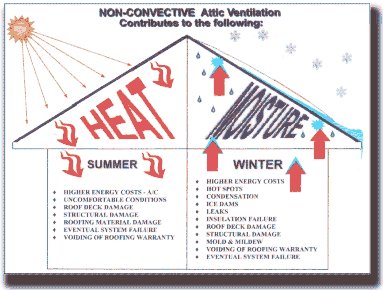Why We Verify Ventilation
Requirements
We verify and measure existing ventilation openings. We
diagnose potential problems and endeavor to educate you, the
consumer. We explain your roof?s requirements exactly and we
give it to you in writing. Occasionally a customer will have
reason to decline the ventilation work as proposed. We will
advise that roofing warranties are worthless if proper
ventilation is not addressed. We also advise of potential
conflicts in a given system. Contrary to sales methods used by
most roofing contractors, we will not always advocate the use of
a Ridge Vent. Ridge Vents are a fantastic form of exhaust
ventilation. If used properly, they can do a world of good. If
used improperly, the results can be disastrous. More important to you, however should be the health of you and your family. Stagnant attic air can cause moisture to condense inside the attic and mold growth can result.
Ventilation
This is a topic that is largely misunderstood by the Roofing Industry.
Proper ventilation is lauded by almost everyone, and rightfully so,
as a key element in roof longevity and energy savings. The impetus
to capitalize on the issue comes, like most things, from a drive for
profit. Often dominating is the profitability equation, where least
amount of labor expended for the contractor combined with the higher
dollar contract amount equals to higher profit. The ventilation issue
is addressed inadequately, the consumer thinks the recommendation
made sounds right, and everyone is happy, until the problems arise.
An improper ventilation system profits no one, especially the roofer
that stakes a reputation on it.
As for mold growth, an imbalance in attic ventilation can create an environment conducive to mold growth.
A Roof That Breaths Will
Last
We verify and measure existing ventilation openings. We diagnose potential
problems and endeavor to educate you, the consumer. We explain your
roof’s requirements exactly and we give it to you in writing.
Occasionally a customer will have reason to decline the ventilation
work as proposed. We will advise that roofing warranties are worthless
if proper ventilation is not addressed. We also advise of potential
conflicts in a given system. Contrary to sales methods used by most
roofing contractors, we will not always advocate the use of a Ridge
Vent. Ridge Vents are a fantastic form of exhaust ventilation. If
used properly, they can do a world of good. If used improperly, the
results can be disastrous.
Mold is always a concern and the only proven way to avert the onset of mold in the attic is to limit moisture. Ventilation prevents mold growth in the attic.
| Please |
|
For
a presentation that will educate you about attic ventilation.
This is a large file (4MB), so it may take a moment or two to
load. |
|
Fiberglass Shingles Require
Proper Ventilation
The fiberglass base shingles of today are especially susceptible to
overheating. See our page on FIBERGLASS
SHINGLES
Ventilation Is the Real
Imperative
While many roofers focus only on the rooftop, we at FSI like to think about all of the elements of a successful
system. The dynamics have changed for every trade in the modern
era, and all trades must adjust to the new aspects of more efficient
living. The deck boards, fasteners, and overall health of the building
are drastically improved by proper ventilation. The old houses of
a century ago, actually ventilated themselves. The drafty windows
and empty wall cavities allowed water vapor to migrate right out of
the building with less chance of condensation than in today's economy.
Lack of insulation in the attics allowed the summer heat to be dissipated
away.
|
Make sure to measure your relative indoor humidity...More Is Not Better
Many have made the mistake of adding exhaust ventilation to their
roof line. This is not an answer to the call for more ventilation.
It used to be that a roofer could add a vent and rely simply upon
thermal buoyancy for hot air to rise and push out of an attic. New
attic insulation practices and the arrival of the fiberglass roofing
shingle, along with the tighter and more efficient homes has caused
some to rethink their methods. |
Winter warm spot concentration was less likely to be a problem
on a roof, especially with the Slate or Tile that possess more mass
than contemporary asphalt shingle. The more the mass of the roof,
the more it tends to spread out heat over a larger area. This effect
can be compared to the difference of a heavy cast iron pot on a stove
being heated with uniformity, even though the heat source is concentrated
in a small area. By contrast, a thin pot will burn in one spot over
the heat source, as it transfers heat quickly, absorbing far less
than the heavy pot.
Modern window, siding, and insulation upgrades
accentuate the necessity for convective air flow under any roofing
system. There is simply more heat in the summer, with the insulated
attics and air conditioned living spaces, and more condensation and
warm attic potential in the winter, in the absence of a convective
system of ventilation.
Winter condensation caused by the closed heated interior areas of the building push water vapor upward into the attic. Attic mold can take hold. The "raining" affect inside of the attic renders insulation useless. Like a wet tee-shirt tends to give you the shivers, wet insulation pulls heat out of the living area.

|
Mixing exhaust vent types is a serious
mistake that is made on most roof tops. Some will say that it makes
no sense to limit exhaust ventilators. These that make such arguments
are not the professionals that hunt down leaks everyday, but the amateurs
that are not experienced with attic ventilation. We will be glad to
discuss your specific attic ventilation needs and make recommendations
after a quick survey of your home.
An imbalance in the attic ventilation can cause conditions conducive to mold growth in the attic. First find the source(s) of the moisture and get a reading on it before changing anything.
Mold in the Attic
The presence of mold in the attic is clear evidence that moisture is present at least part of the year. In the climate of the Northeast, winter provides a perfect environment, in some attics, for mold to flourish. The “warm attic syndrome” is a condition where attic insulation, ventilation and possible air leakage into the attic, are contributing to moisture and temperatures favorable for mold growth. Readily present in the environment, mold will grow if it has food, undisturbed moisture and warmth. The type of mold we find in attics is of the type that feeds on dead organic material and thrives in darkness. This organism is simple to destroy if you get it early.
Mold grows and reproduces quickly, so it is important to move quickly. If you suspect that you have a mold problem, you should call us for a free evaluation.
Note: Inproving Ventilation and Insulation without Proper Air Sealing will only cause increased moisture problems.
We provide you with a written ventilation
recommendation based upon government specifications. With this form
and your new roof, you have added value and assurance that your roofing
system will last the test of time.
Call
us or drop an email (click below) for an estimate and we will
be happy to explain.
|
Attic mold under your roof is a serious problem that should be addressed.
Basement Waterproofing
Mold remediation expert |



